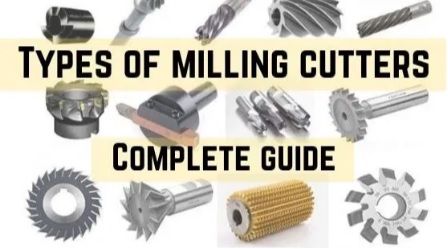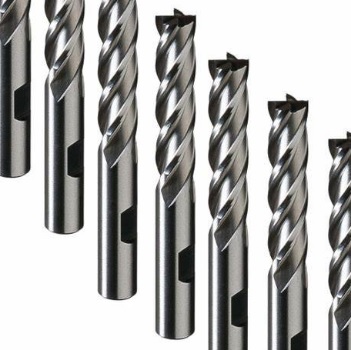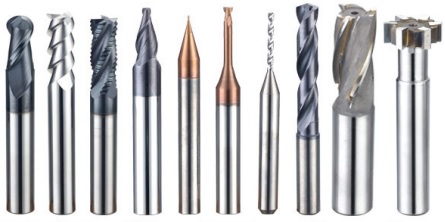Complete Guide - Types of Milling Cutters
With the rapid development of milling cutters from 1783 to the present, various milling cutters of different materials have appeared. How to choose the right milling cutters for the machine tool, so that the CNC machining can quickly improve the processing efficiency and increase productivity. It is necessary to understand the basic knowledge of types of milling cutters. Milling cutters can be classified by the milling cutter material, blade, cutter body and blade type.

Classified by milling cutter material
1. White steel milling cutter: also known as high-speed steel, the hardness is relatively soft, the high-speed steel cutter is cheap, the toughness is good, but the strength is not high, it is easy to let the knife, and the wear resistance, thermal hardness is relatively poor, the thermal hardness of the high-speed steel milling cutter is 600 When the hard material is milled with white steel, it is easy to burn the knife if the coolant is not in place. This is one of the reasons for the low thermal hardness.
2. Cemented carbide milling cutter: Cemented carbide (tungsten steel) has a series of excellent properties such as good thermal hardness, wear resistance, good strength and toughness, heat resistance and corrosion resistance. In particular, the high hardness and wear resistance remain basically unchanged even at 500 degrees, and still have high hardness at 1000 degrees.
3. Ceramic milling cutter: also known as oxidation milling cutter, with extremely high hardness, heat resistance up to 1200 degrees, and extremely high compressive strength, but the brittleness is too high so the strength is not high, so the cutting amount cannot be too large. Therefore, it is more suitable for final finishing or other highly wear-resistant non-metallic processed products.
4. Superhard material milling cutter: It is excellent in terms of hardness, wear resistance and heat resistance. It has sufficient toughness and can withstand temperatures up to 2000 degrees. It is more suitable because of its brittleness and low strength. Final finishing.

Classified by manufacturing method of milling cutter
1. Grinding blade: This kind of blade has better dimensional accuracy, so the positioning accuracy of the cutting edge in milling is higher, and better machining accuracy and surface roughness can be obtained. The ground blade with large rake angle can be used for milling viscous Material (such as stainless steel). Through the shearing action of the sharp blade, the friction between the blade and the workpiece material is reduced, and the chips can quickly leave in front of the blade.
2. Pressed blade: It is best to choose a pressed blade for roughing, which can reduce the processing cost. The dimensional accuracy and edge sharpness of the pressed blade are worse than the sharpened blade, but the pressed blade has better edge strength and is resistant to impact during roughing. And can withstand larger depth of cut and feed.
3. Combined blade: Install the pressing blade in the blade seat of most milling cutters, and configure a polished scraper blade to remove rough machining marks.
Classification by milling cutter body
When choosing a milling cutter, the size of the tooth pitch will determine the number of cutter teeth that participate in the cutting at the same time during milling, which affects the smoothness of cutting and the requirements for machine tool cutting rate.
1. Coarse tooth milling cutter: It is mostly used for rough machining because it has a large chip pocket. If the chip pocket is not large enough, it will cause difficulty in chip curling or increase the friction between the chips and the tool body workpiece, and the chip load per tooth of the rough tooth milling cutter It is larger than the close-tooth milling cutter.
2. Close-tooth milling cutter: It is more used for finishing milling. The depth of cut is shallow during finishing milling, the power required is not large, and a larger feed can be selected.

Classification by milling cutter blade
1. Flat-bottom milling cutters: also known as end mills, smooth cutters, gong cutters and purple cutters. They are often used for finishing, semi-finishing, and finishing of machining planes, side planes, grooves, and mutually perpendicular step surfaces. The number of milling cutters is more More, the better the effect after finishing.
2. Coarse milling cutter: also known as wave edge cutter, used for rough machining of the workpiece surface. According to the tooth profile of the wave edge, it is divided into coarse teeth, middle teeth and fine teeth. The tooth profile is different, and the processing parameters are also different. In general, the type of milling cutter allows a larger amount of cutting, so the roughening of the workpiece is the first choice.
3. Ball-end milling cutter: Because the shape of the blade is spherical, it is called ball-end milling cutter, also called computer ball cutter or R milling cutter. It is often used for semi-finishing and finishing of various curved surfaces and arc grooves.
4. Round nose milling cutter: also known as bull nose milling cutter or fillet milling cutter. It is mostly used for processing right-angle step surfaces or grooves with R angles, and is mostly used for semi-finishing and finishing.
5. Copper and aluminum milling cutter: It is mainly made for the characteristics of copper and aluminum materials. It is characterized by large rake angle, large relief angle (sharp tooth), large spiral, and good chip removal effect. It is the first choice for copper and aluminum processing.
6. T-slot milling cutter: mainly used for T-slot and side groove processing.
7. Chamfering cutter: Mainly used for inner hole chamfering and shape chamfering of molds. The chamfering angles are 60 degrees, 90 degrees and 120 degrees.
8. Internal R milling cutter: also known as concave arc end mill or reverse R ball cutter, it is mostly used for milling and processing convex R-shaped surface.
9. Countersunk head milling cutter: It is mostly used for processing hexagon socket screws, mold thimble, and mold nozzle countersink.
10. Oblique knife: also known as taper knife, it is mostly used for taper surface processing after ordinary blade processing, mold draft allowance processing and concave part processing. The slope of the tool is the degree of one side.
11. Dovetail milling cutter: It is shaped like a dovetail, and is mostly used for processing dovetail grooves.
After reading this article, you should have a clear understanding of the types of milling cutters.


